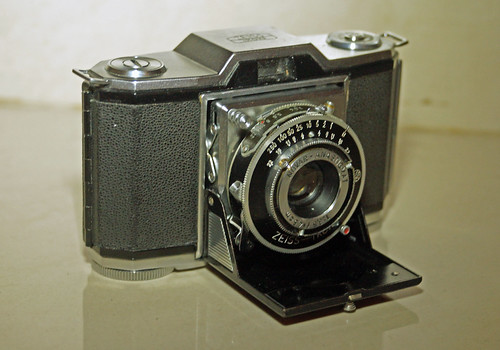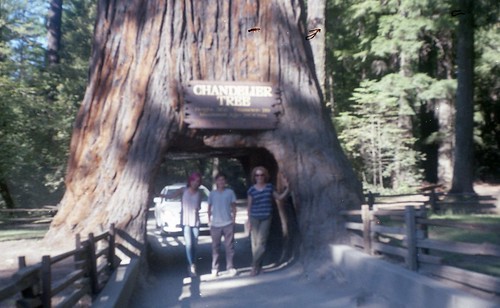I was reminded today that I have a long way to go in building my vintage camera collection – the world record holder, who lives nearby in Mumbai, has a collection of 4,425. At least, he did when this article was published. The thing about my (much smaller) collection is, however, that I try and limit myself to cameras I can actually use.
The Zeiss Ikon Ikonta 35, later improved and renamed the Contina, is one such camera – one that I particularly like because of the clever way it’s designed. After World War II, the Zeiss company, which had been making cameras for a number of years, faced a tenuous future. Hubert Nerwin, in his private time, designed a 35mm camera that would slip into a shirt pocket. This Ikonta 35 soon became a popular item in U.S. military exchanges in Germany, and many soldiers brought a copy back to the States after spending time in Germany.

These cameras were manufactured from 1949 to 1953. This particular Ikonta is probably from around 1950 or so. It wasn’t one of the first models, which were made using Schneider Xenar lenses, and also not one of the later models, which included an accessory shoe on top.
The camera has a number of clever innovations that make it especially interesting. Moving the film winding mechanism to the underside of the camera, two dials that are not much larger than a quarter, and mounted flush with the camera, helped reduce the size of the camera and remove protrusions from its top surface. The entire lens assembly pops into place when you open the little door on the front, and it remains firmly in place until you squeeze the struts together. It’s got tiny, delicate knobs and dials in addition to a flash synchronization contact and a place for the cable release.

On the front you can see the various settings available, all accomplished with tiny calibrated dials that make other cameras from that time frame appear clunky in comparison. The red knob on the bottom is a timer, and the shutter winding lever is on the top (visible just above shutter speed markings 2 and 5 – representing 1/2 and 1/5 second, respectively. Unlike many cameras of the day, which required you to reach out somewhere on the lens and find a lever to release the shutter, or else had some sort of button on top that connected to the lens with levers, with the Contina you just press down on the small knob/lever on the top left (facing the photo above) of the lens – shades of the plastic cameras that would follow later in the 1950s, through the 1970s.

Until I found an online manual for the camera, a couple of its basic features eluded me. One was how to get the thing open – there is a small slider carefully hidden on one side of the camera to look like decoration. Until I got it open I couldn’t load the film, which was necessary to determine whether the camera worked – as the shutter and several other mechanisms can’t be tested without film in the camera. It was then that I discovered that the designers had built in a mechanism to prevent double exposures.
Once I completed the roll, I was again stumped, as I couldn’t figure out how to release the film so it could be rewound. I finally found a carefully camouflaged button in the center of the film advance disk – once depressed, the disk on the other side of the camera’s bottom could be used to rewind the film.
Unfortunate and very disappointing however is the fact that all of the photos appear to be blurry. I’ve had cameras where the focus mechanism – basically a threaded lens that moves toward and away from the film as it is turned – is somehow mis-calibrated; but when this happens, a few of the photos will turn out, and you just need to figure out how to compensate for the miscalibration. On this one they all are blurry, almost as if taken through a cheap plastic lens; but the lens itself is clear without any damage. I’m considering tinkering with the three tiny screws that hold it in place, but hesitate to take it apart and try and clean it, as it was around this time that manufacturers began coating lenses.
A few examples follow. Compare to another Contina owner’s photos (much clearer!). Happy for any suggestions.





